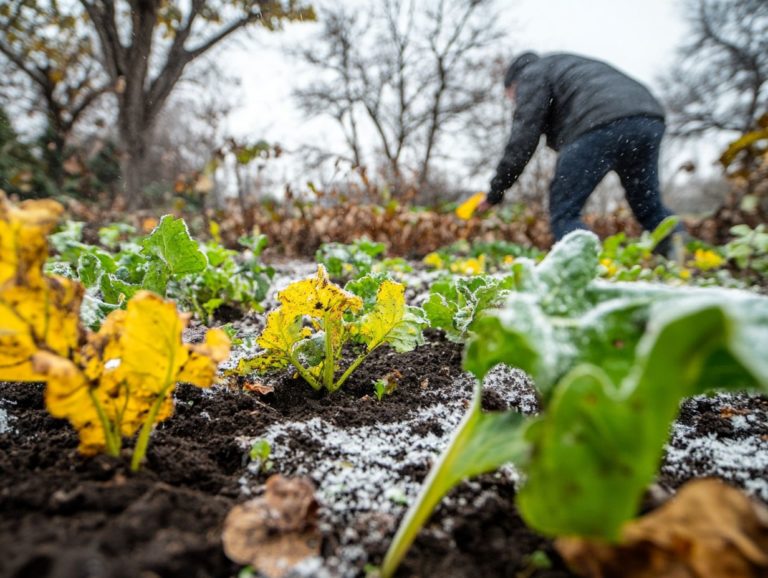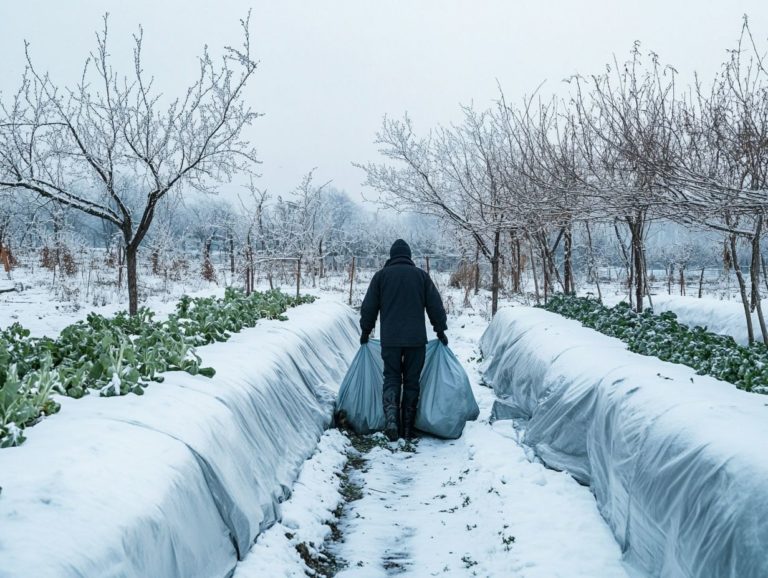Preparing Your Garden for Winter: Essential Steps
As the days shorten and winter’s chill encroaches, it’s the perfect moment for you to reflect on your garden s health and vitality.
Preparing your garden for winter is essential to ensure it bounces back vibrantly in the spring. From clearing away debris to insulating your plants, every step is crucial in protecting your garden through the colder months.
This guide will walk you through the necessary preparations, illuminate the benefits of winter care, and equip you for a flourishing spring. Embrace the opportunity to nurture your garden, even amidst the frost!
Contents
- Key Takeaways:
- Why Preparing Your Garden for Winter is Important
- Clearing and Cleaning Your Garden
- Protecting Plants and Soil
- Preparing for Spring
- Frequently Asked Questions
- What are the essential steps for preparing my garden for winter?
- When should I start preparing my garden for winter?
- Do I need to remove all dead plants and debris from my garden?
- How can I protect my delicate plants from the cold?
- Why is it important to fertilize and mulch before winter?
- What should I do with my garden beds before winter?
Key Takeaways:
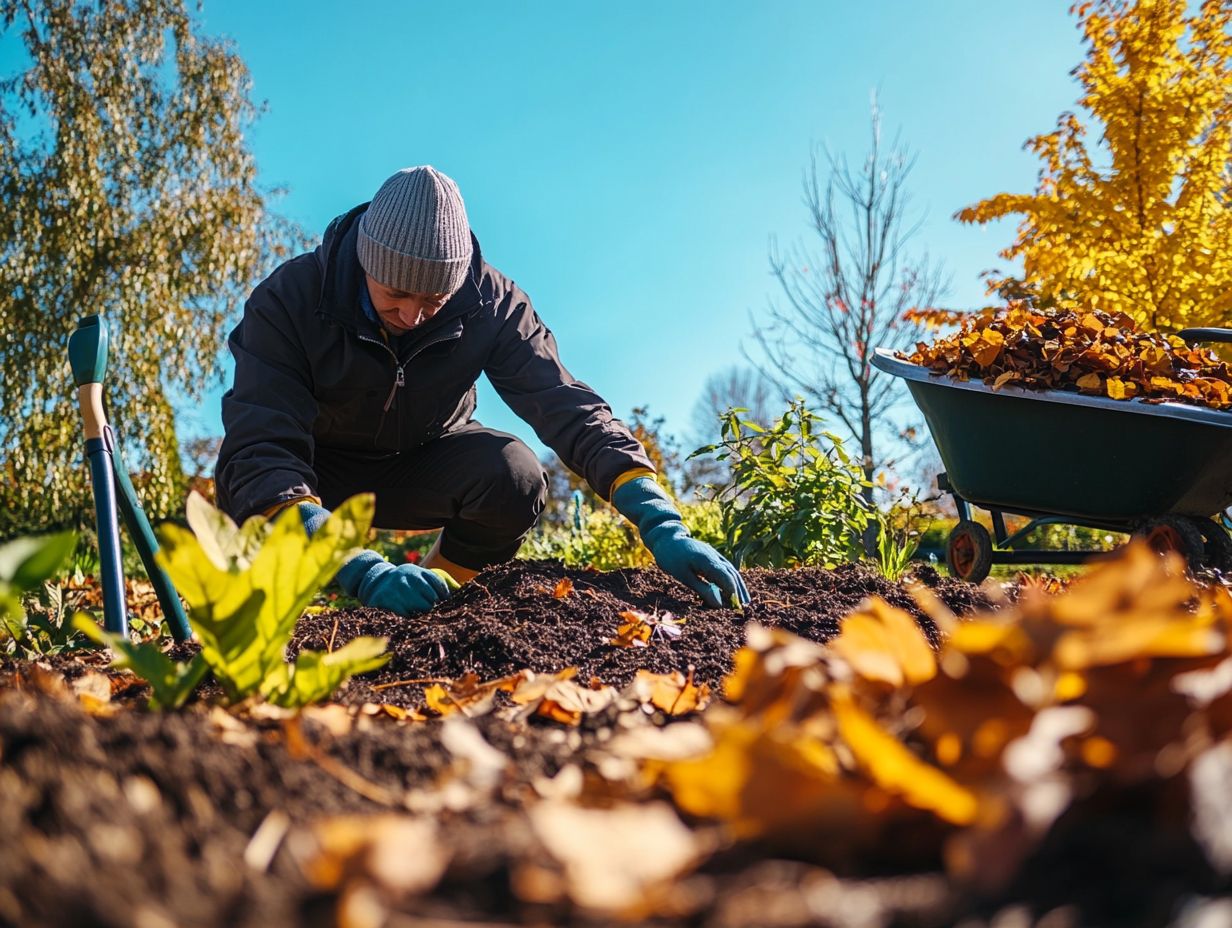
- Properly preparing your garden for winter is crucial for the health and longevity of your plants.
- Clearing and cleaning your garden, including removing debris and pruning plants, is an essential first step in winter preparation.
- Protecting plants and soil through insulation and mulching, as well as planning for spring, are important steps in preparing your garden for the colder months.
Why Preparing Your Garden for Winter is Important
Preparing your garden for winter is essential for safeguarding the health and productivity of your plants in the seasons ahead. A thoughtfully prepared garden not only shields the soil and plants from harsh winter conditions but also sets the stage for a flourishing spring garden. For specific strategies, consider preparing your garden for the first frost.
By proactively incorporating compost and mulching, and addressing the specific needs of your climate, you can cultivate a vibrant green space that thrives for years to come. This careful preparation ensures that important nutrients are preserved, allowing your gardening efforts to bring you joy and satisfaction in abundance.
The Benefits of Winter Preparation
The benefits of winter preparation for your garden are truly many, significantly enhancing both plant health and soil quality. Utilizing tips for sustainable winter gardening can further improve your garden’s resilience during the colder months.
By dedicating some time to improve your soil structure through methods like mulching covering the soil with a layer of material to protect it and incorporating organic matter, you can effectively boost nutrient retention. This ensures that your crops will have all the essential elements they need when spring arrives.
Adopting this proactive approach not only fortifies your garden against diseases but also lays the groundwork for impressive yields especially for crops like garlic, which thrive in well-aerated soil. Implementing proper winterization techniques also works wonders for tomatoes, preventing root rot and fostering robust growth in your vegetables.
Ultimately, these thoughtful preparations cultivate an environment where your plants can truly flourish, paving the way for a bountiful harvest.
Clearing and Cleaning Your Garden
Clearing and cleaning your garden is a vital step in preparing for winter, setting the stage for a fresh start in the upcoming growing season. This process entails removing debris, dead plants, and weeds using the right tools and equipment, as outlined in winter plant care: essential guidelines.
Not only does this tidy up your space, but it also reduces the chances of diseases and pests taking refuge in your garden beds over the winter. A meticulous cleaning improves soil aeration and boosts the efficacy of any amendments or compost you plan to apply, creating a healthier environment for your plants come spring.
Removing Debris and Dead Plants
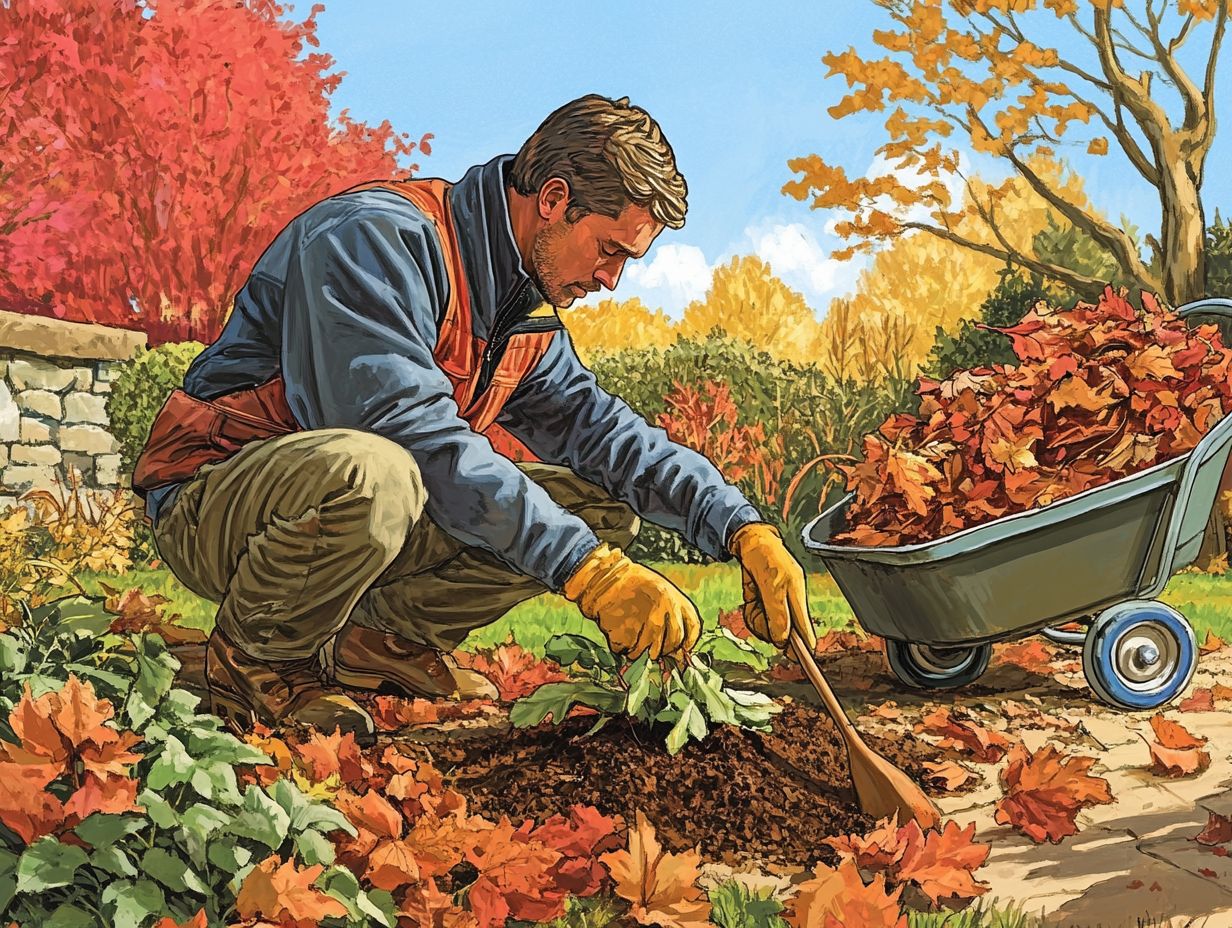
Removing debris and dead plants from your garden is essential for preserving the health of your soil and plants for the upcoming season. This crucial task not only makes your garden look great but also sets you up for a thriving season ahead!
By employing techniques such as raking, mulching, and composting, you can effectively clear away unwanted materials. Proper disposal of deceased plants is equally crucial; it helps prevent diseases and pests from taking hold, ensuring a thriving environment for future growth.
Engaging in these practices supports nutrient cycling and enhances soil structure, leading to healthier plants and a more vibrant ecosystem in your garden.
Pruning and Trimming
Pruning and trimming are essential practices in maintaining your garden, especially as winter approaches. For those interested in preparing for the colder months, exploring seed starting for winter can enhance the health and growth of your plants.
By removing dead plants or overgrown branches, you encourage better air circulation and light penetration, both vital for thriving perennials. This careful intervention stimulates new growth and prevents diseases, giving your garden a vibrant appearance.
To achieve the best results, it s important to use the right tools sharp pruning shears, loppers, and saws. Clean cuts minimize harm to your plants. Timing is crucial; late winter or early spring is the ideal time for pruning most perennials, allowing for the best recovery as they enter their growing season.
Employing techniques like thinning and shaping will help you maintain an attractive structure while promoting robust health in your garden.
Protecting Plants and Soil
Protecting your plants and soil during winter is essential for their survival and health as the seasons shift. Use winter planting strategies now to safeguard your plants!
Insulate delicate plants and apply mulch to maintain optimal soil temperature and moisture levels.
By taking these precautions, you safeguard your crops and preserve vital nutrients, contributing to a resilient garden environment come spring. The right protective measures can significantly enhance your success in cultivating a thriving garden year after year.
Insulating Plants
Insulating your plants during winter is an essential protective measure that enables them to endure cold temperatures and harsh conditions.
Employ a range of techniques to enhance your plants‘ resilience, such as using cover crops plants grown to improve soil quality. One popular method is using row covers, which create a greenhouse effect that traps heat and shields against frost. Burlap is another effective option, allowing for air circulation while protecting delicate foliage from chilling winds. Layering mulch around your plants creates a protective barrier, helping to retain soil warmth and moisture.
These insulation strategies not only protect your plants from the potential damage of winter squalls but also encourage healthier growth when spring arrives.
Mulching and Covering Soil
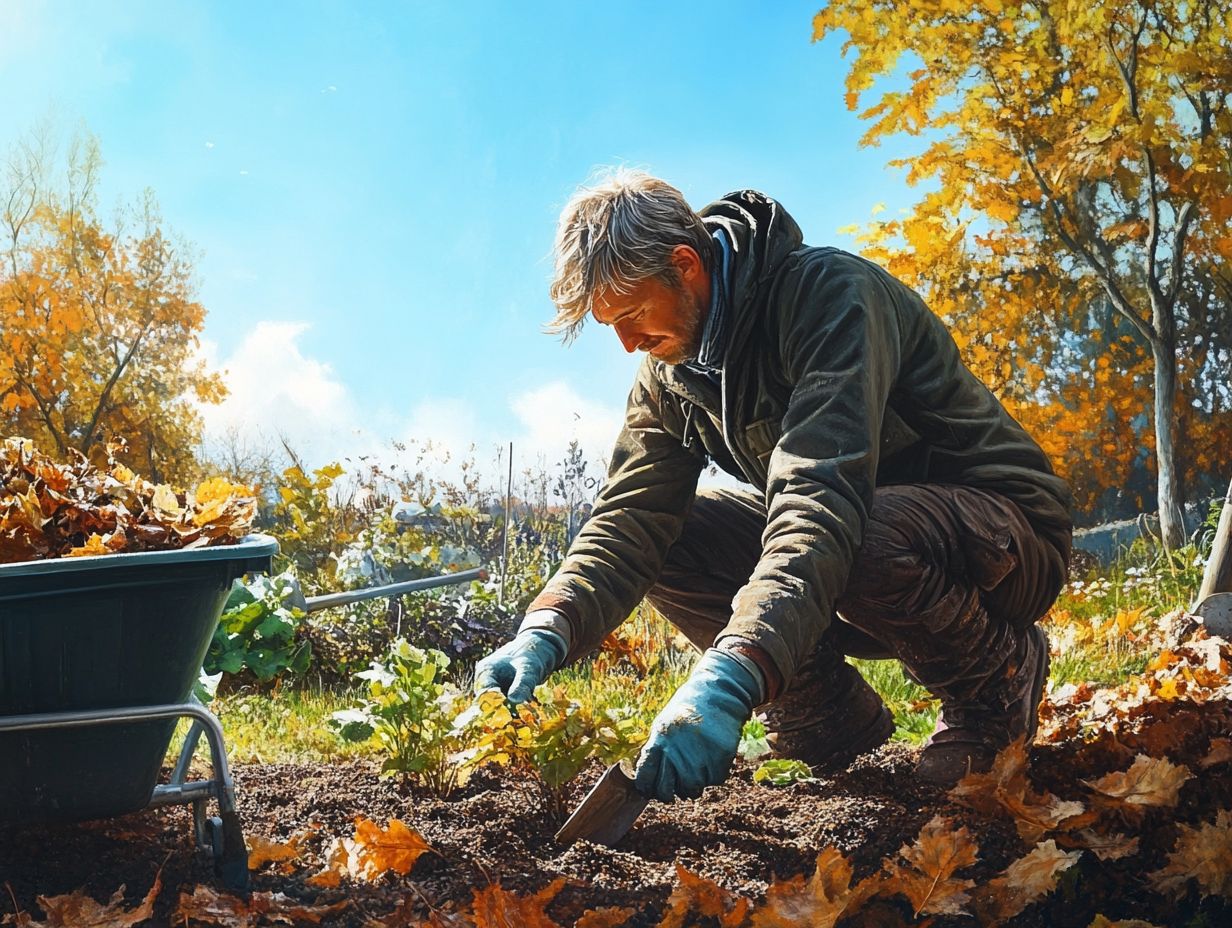
Mulching and covering your soil are highly effective practices that provide essential protection during the winter months. Embrace these methods to significantly enhance soil health, creating a hospitable environment for your plants to flourish.
Mulching aids in moisture retention crucial for robust root development and helps regulate soil temperature, safeguarding delicate organisms below from extreme fluctuations. It plays a pivotal role in nutrient preservation, as organic materials decompose and enrich the soil.
Choose suitable mulching materials such as:
- Straw
- Wood chips
- Shredded leaves
Applying a layer of mulch at least two to three inches thick ensures maximum effectiveness while promoting sustainable gardening practices.
Preparing for Spring
Preparing for spring in the winter months requires strategic planning and deliberate actions that lay the groundwork for a bountiful growing season. Carefully select and plant bulbs or winter crops, while considering essential maintenance tasks that enrich soil quality and bolster plant health.
By mapping out your spring activities now, you set the stage for a garden that bursts with vibrant colors and abundant yields. Maximize the benefits of your winter preparations!
Start your winter preparations today to ensure a successful garden in spring!
Planting Bulbs and Winter Crops
Planting bulbs and winter crops is rewarding and fun! You ll yield delightful results when executed with care and precision.
As you anticipate the warmth of spring, get ready for vibrant blooms and fresh produce that begin to bubble within you. By selecting hardy bulbs like daffodils, tulips, and crocuses alongside winter crops such as kale, spinach, and radishes, you can start crafting your breathtaking garden today, offering both beauty and nourishment.
To ensure your plants thrive, proper soil preparation is essential. This includes loosening the soil and incorporating organic matter, like compost, to enhance both drainage and nutrient content.
With the right conditions in place, your early plantings can flourish, setting the stage for a generous harvest in the months to come.
Planning for Spring Maintenance
Planning for spring maintenance is an essential step in ensuring your garden flourishes throughout the growing season. This proactive approach lays a solid foundation for healthy plants and helps you pinpoint the specific gardening tools and equipment necessary to tackle various tasks.
From shovels and trowels to pruning shears and compost bins, having the right tools minimizes delays and boosts your efficiency. Establishing ways to improve soil health, such as soil testing (which checks nutrient levels) and appropriate fertilization, is crucial for promoting plant vitality.
By weaving these elements into a comprehensive maintenance schedule, you can cultivate a thriving ecosystem that supports healthy growth and generous yields. This includes planning for the fall and winter seasons. Ensure to test soil and add necessary amendments.
Frequently Asked Questions

What are the essential steps for preparing my garden for winter?
The essential steps for preparing your garden for winter include cleaning up debris, protecting delicate plants from the cold, fertilizing and mulching, and getting garden beds ready for spring planting.
When should I start preparing my garden for winter?
The ideal time to start preparing your garden for winter is in late fall, once the majority of your plants have died back and the weather cools down. This gives you enough time to complete all necessary tasks, including protecting your garden from winter pests, before the first frost hits.
Do I need to remove all dead plants and debris from my garden?
Yes, it is important to remove all dead plants and debris from your garden before winter. This helps prevent the spread of diseases and pests, making it easier for you to start planting in the spring.
How can I protect my delicate plants from the cold?
There are a few ways to protect delicate plants from the cold. You can cover them with a layer of mulch, wrap them with burlap or frost cloth, or move them to a more sheltered location. Make sure to research the specific needs of each plant before deciding on a method.
Why is it important to fertilize and mulch before winter?
Fertilizing and mulching before winter helps provide nutrients for your plants during the dormant season. It also helps insulate the soil and protect root systems from harsh temperatures. This results in healthier, stronger plants in the spring and a successful harvest.
What should I do with my garden beds before winter?
Before winter, it is important to prepare your garden beds for spring planting. This includes removing any remaining plants, tilling the soil, and adding compost or other organic matter such as cover crops. You can also cover the beds with a layer of mulch to protect them from the cold and prevent weeds from growing. For detailed strategies, refer to the essential guide to gardening in cold weather.
Start your garden today and watch it thrive this spring!




